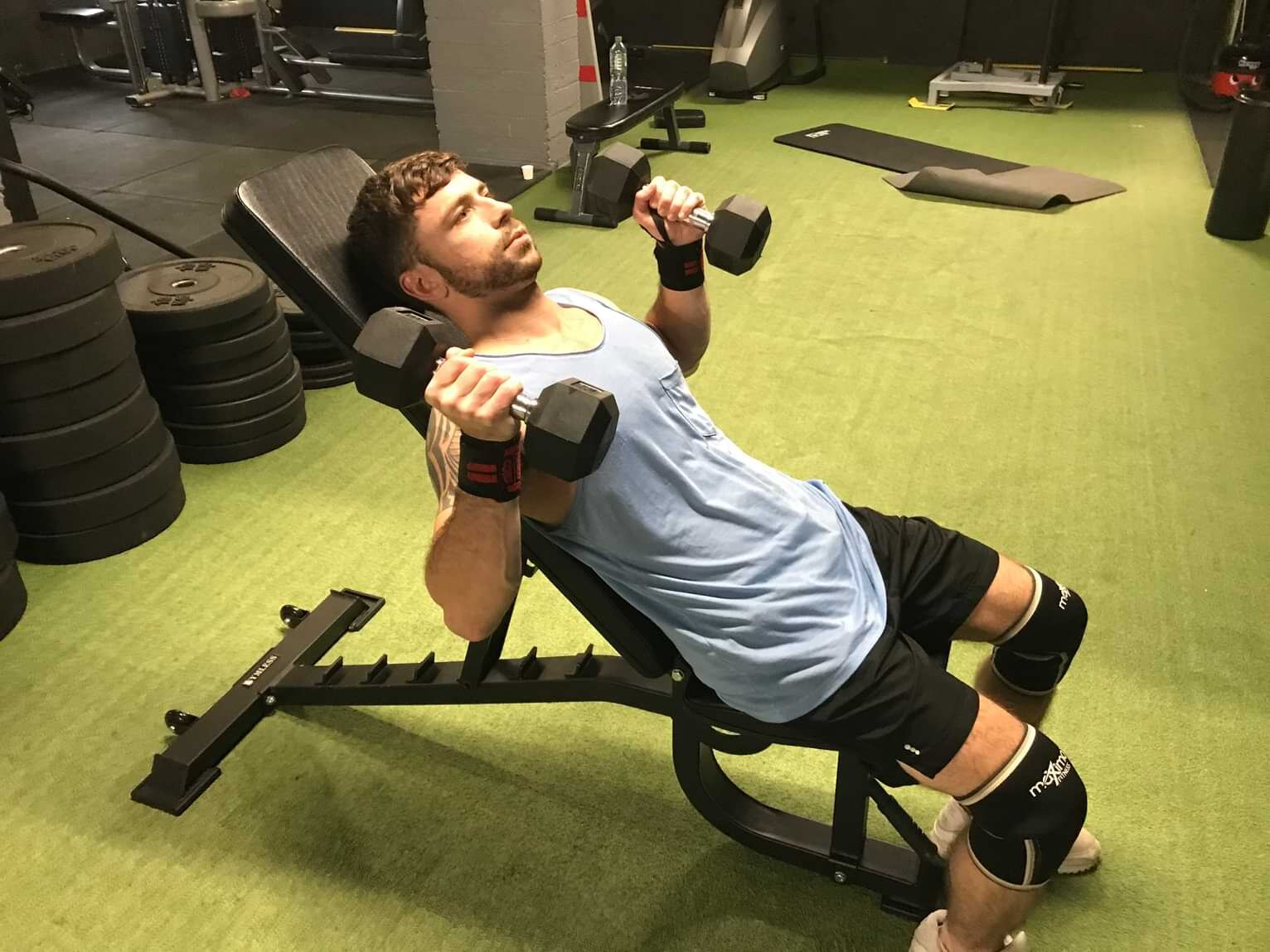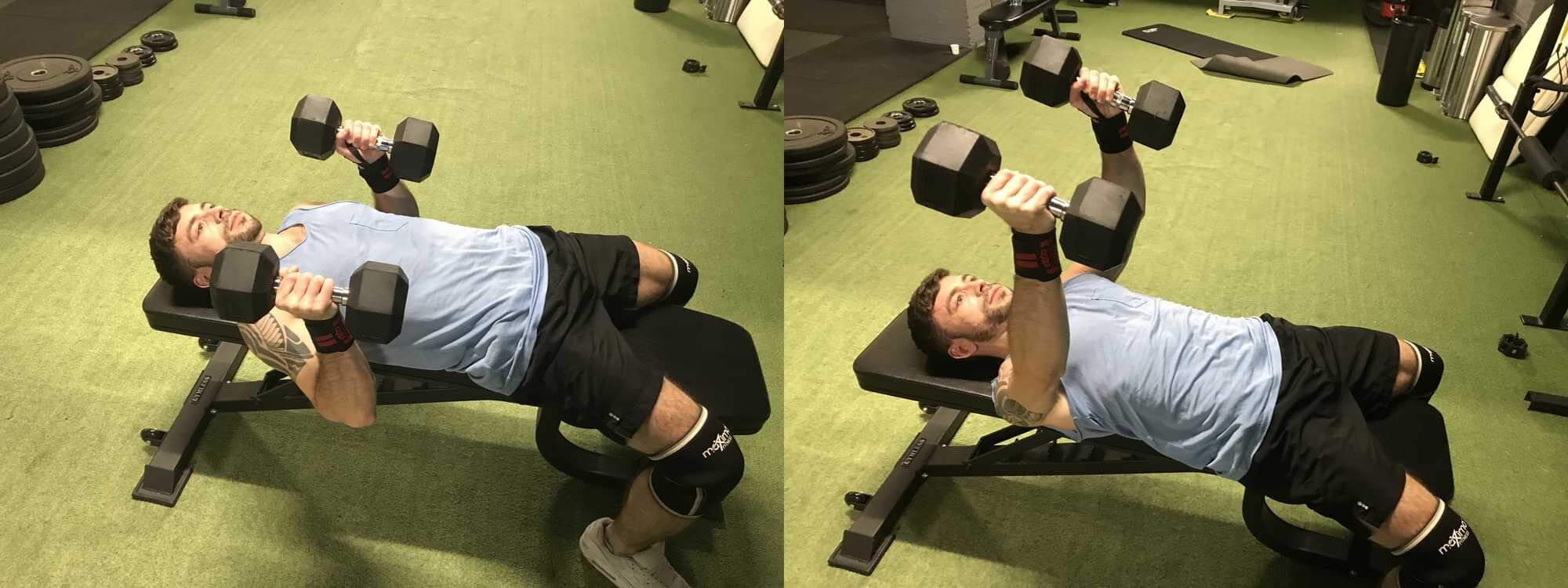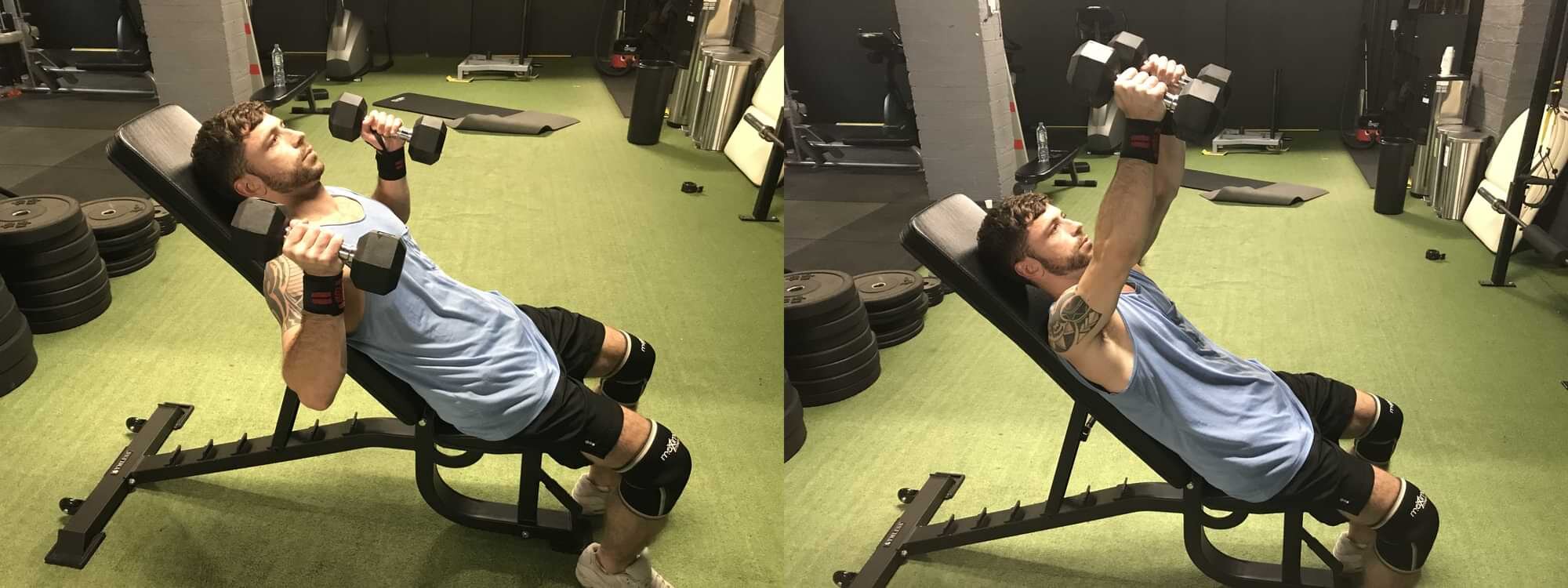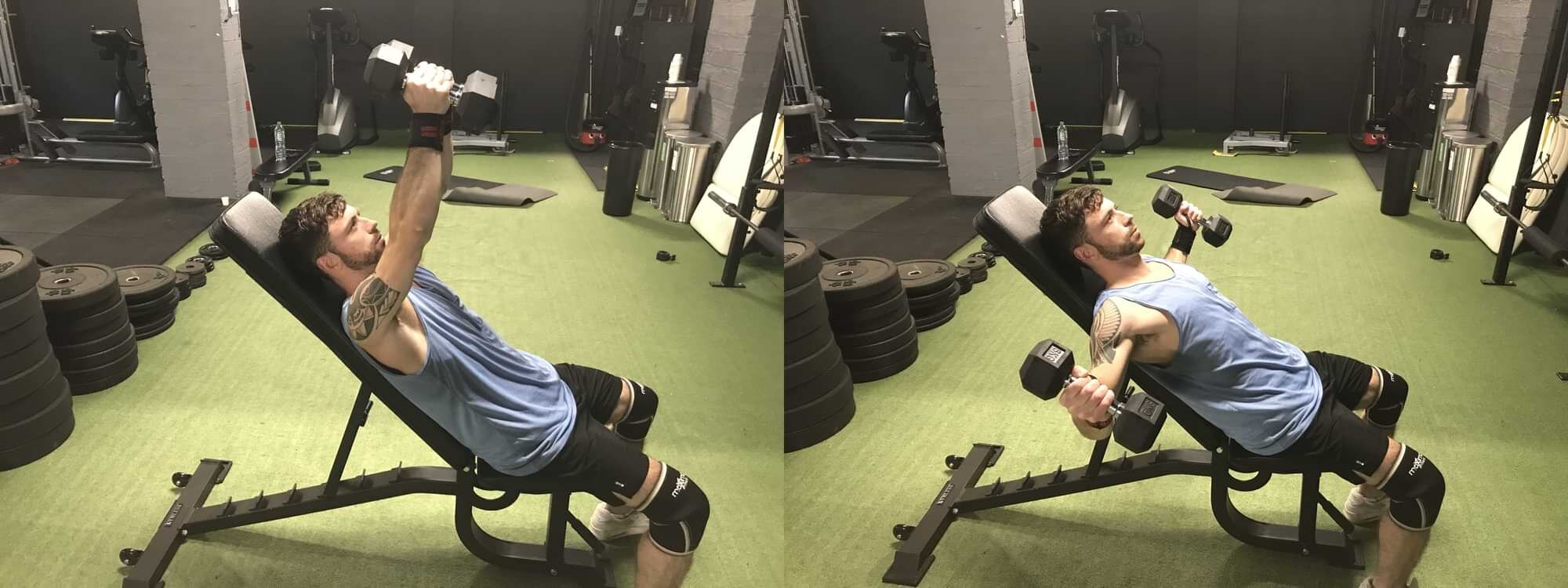19 VARIATIONS OF THE DUMBBELL CHEST PRESS
WHY DO YOU NEED TO MAKE CHANGES TO YOUR CHEST PRESS EXERCISES?
There’s many reasons why you need to make changes to your chest press exercises. To keep gaining strength and building lean muscle mass, we need to demonstrate the ability to "trick" our muscle fibers. Our pecs stop growing the when muscle fibers learn and adapt to the same chest press routine. They eventually lose their ability to break down, repair and develop lean muscle (plateau). However… by changing the grip, we're creating a new movement for the “mind-muscle connection”. By creating new movement patterns, the muscle fibers continue to respond in that same “muscle building manner”. To make sure things keep moving in the right direction, you need to constantly change your chest press workout on a weekly basis.
HOW IS IT DONE?
PERFORM DIFFERENT ANGLES OF THE DUMBBELL CHEST PRESS
Let’s take a look at a good example over a three week period:
One week you decide to perform the "dumbbell chest press" exercise with a pronated grip. Having performed the routine 2/3 times within a week, you decide to change things up and perform "neutral grip" for the second week. Lifting the same weight in this “new position”, you manage to complete the same number of sets and repetitions. Your muscle fibers continue to break down by responding to the new movement pattern. In week 3, you circulate back to lifting with a pronated grip. This time you decide to increase the weight in slight increments for both dumbbells. You manage to perform 8-12 repetitions within this weight range. From here, you’ll want to record your stats (weight, reps, sets, rest times), rotate to different chest press exercises (record your stats), and rotate back to performing the same drill again to make improvements. This is the effective way to use variations and make progress with the dumbbell chest press exercise.
Interesting Resource:
The Art of Using Angles for Increased Strength
COMBINE THE MOVEMENTS
Another reason for rotating chest press exercises is the recruitment of more muscles. When we perform different variations, we recruit different muscles that become "more" and "less" dominant to execute the lift. By opting for a different selection each time, you can put more emphasis on different muscles while putting less strain on the shoulder joints (or muscles and joints being overworked). This is important for enhancing performance and recovery. By targeting various muscle fibers, we're also strengthening supporting muscle groups at the same time. Over successive weeks, you'll notice that your muscles are more functional, balanced, and conditioned to push more weight while maintaining correct form.
Note: It’s recommended that you add 3-4 Chest Exercises To Each “Chest Workout” for achieving hypertrophy (Muscle Growth).
WHAT IS THE MIND-MUSCLE CONNECTION?
The mind-muscle connection refers to focusing on a muscle being worked during a strength training exercise. It’s the difference between going through the same motions repeatedly and actually making a connection with your muscles. The objective is to stimulate your motor abilities. This is done by adding a set of variables. These variables make a connection by adding something “new” to the exercise. This allows the mind and muscle tissues to engage and respond, allowing them to continuously break down and respond. Arnold Schwarzenegger touched upon these details in his documentary “Pumping Iron”.
3 examples of changing these variables include: changing the tempo of a lift, the position, and the hand grip.
References:
6 Ways To Improve Your Mind-Muscle Connection
Can Using The Mind-Muscle Connection Enhance Hypertrophy?
DIFFERENT HAND GRIP POSITIONS FOR THE DUMBBELL CHEST PRESS
Today we’re going to look at how we can change the variables of the “Dumbbell Chest Press”. We’ll show you how to use different hand grips and change the position of each exercise. This will target the upper, medial, and lower fibers of the pectoral muscles in different planes (flat, incline, decline positions on the bench). All these factors are key for growing the muscle cohesively.
PRONATED GRIP: A Pronated Grip is the method of lifting in an “overhand” position. When performing the “dumbbell chest press” on a bench, the palms are facing away from the body in a southern direction towards your feet.
NEUTRAL GRIP: A Neutral Grip is the method of lifting in a “side grip” position. When performing the “dumbbell chest press” on a bench, the palms are facing each other and towards the midline of the body.
ROTATIONAL GRIP: A Rotational Grip is the method of starting each rep of the dumbbell chest press in a “neutral grip position” (hands vertical) and finishing in a “pronated grip position” (hands horizontal).
It’s important to note that each exercise targets the greater portion of the pec muscle fibers, with emphasis put on different areas of the muscle group.
DUMBBELL CHEST PRESS
The "Flat Dumbbell Chest Press" is the king of exercises for developing your pec muscles overall. When performing the exercise on a flat surface (90 degrees), it recruits most of the muscle fibers in your pectoralis major. Most of these fibers are located in the medial area of the muscle. The triceps work as a secondary muscle group with lighter focus on the anterior delts (front shoulders).
HOW TO DO THE DUMBBELL CHEST PRESS
Start by sitting at the end of the bench. Rest both dumbbells on your thighs and hold them in neutral position.
As you lie down, manoeuvre your hand grip to a pronated position on both sides. Your palms should be facing south of your body and arms a little wider than shoulder width apart.
As you begin to lift, extend both arms directly above your chest. In the finish position, the dumbbells should be positioned horizontal and a few inches apart. Slowly bend your elbows to lower yourself back to the starting position.
Repeat for several repetitions.
PRONATED GRIP
FLAT BENCH DUMBBELL CHEST PRESS
Variation 1
When performing the “flat dumbbell chest press” with a pronated grip, the elbows are extended in a wider position. Your chest acts more as a prime mover and dominant muscle group. The pecs work harder to push the weight with your triceps being less active as a secondary muscle group.
NEUTRAL GRIP
FLAT BENCH DUMBBELL CHEST PRESS
Variation 2
Performing the dumbbell chest press in neutral position strengthens the chest, shoulders, and triceps. It's important to highlight that neutral grip places more emphasis on the triceps muscles and allows for an extended range of motion. It's also a great variation to apply for reducing strain on the shoulder joints. While the pronated position is better for isolating the pec muscles, the neutral position is great for targeting the inner fibers (medial) of the pectoralis major. It’s essential to add this variation to your chest press program for building the muscle group.
PERFORMANCE TIP: When performing the dumbbell chest press with a neutral grip, the same from applies. Just make sure to keep the dumbbells more medial to the body when lifting. Lift directly upwards without extending your arms wider than shoulder width.
ROTATIONAL GRIP
FLAT BENCH DUMBBELL CHEST PRESS
Variation 3
The variable of rotation allows for more muscle activation and requires more coordination. The motion of transferring from neutral to pronated grip is a unique method for working your shoulders and testing the muscle fibers of your pecs. It creates a new movement pattern for your muscle fibers and stimulates a response as they contract (mind-muscle connection). The rotational grip is an affective strategy for mixing up your chest press routine and adding a new variable for muscle break down.
PERFORMANCE TIP: When performing the dumbbell chest press with a rotational grip, make sure to transfer from a neutral position to a pronated position as soon as you start to lift. This makes the transition easier and maintains good form.
INCLINE DUMBBELL CHEST PRESS
The "Incline Dumbbell Chest Press" is beneficial for targeting the upper fibers of your pectoralis major. In other works, it builds and strengthens your upper chest. As this exercise is performed in a more upright position (45 degrees), it puts a lot more emphasis on your shoulder muscles (anterior deltoids) and safer for your rotator cuff.
Note: Perform this exercise the same way as the “flat bench dumbbell chest press” except at 45 degrees.
PRONATED GRIP
INCLINE BENCH DUMBBELL CHEST PRESS
Variation 4
The benefits of performing the “incline dumbbell chest press” are similar to the “flat bench” version of the exercise. If you want to isolate and target the upper fibers of your pec major effectively, then perform the workout with a pronated grip. This is the best exercise for recruiting most of your clavicle fibers.
NEUTRAL GRIP
INCLINE BENCH DUMBBELL CHEST PRESS
Variation 5
The neutral grip variation of the “incline dumbbell chest press” targets the medial fibers of the upper pectoral muscles. It activates your anterior delts and triceps as more dominant muscle groups while working your “upper chest”. This variation is beneficial to do after any chest exercise done with a pronated grip. Why? The inclined version of the chest press is very challenging to do as it recruits less fibers from the pec major muscle. That’s why it’s always easier to lift heavier on a flat bench. Any chest workout done with a pronated grip will exhaust the muscle group pretty quickly.
By switching to an exercise with neutral grip directly after, we can maximise the output of these fibers with the assistance of supporting muscle groups. This is an effective strategy for staying within the goals of hypertrophy and achieving a higher rep count (8-12 reps).
ROTATIONAL GRIP
INCLINE BENCH DUMBBELL CHEST PRESS
Variation 6
Executing the rotational grip (neutral to pronated) during the incline dumbbell chest press can help alleviate stress on the elbow and shoulder joints. It’s also an effective strategy for targeting the inner/outer muscle fibers of the upper pecs. Once again, the rotational movement stimulates muscle growth in the upper chest by offering a new variation. It’s a pattern that differentiates from the basic “prone” and “neutral” grip movement. The method of turning the wrists helps to trick the muscle fibers and build a bigger upper chest.
DECLINE DUMBBELL CHEST PRESS
The "Decline Dumbbell Chest Press" targets the lower fibers of the pecs. It’s not as essential for building the muscle group when lifting in other positions (flat, incline). Nevertheless, incorporating all three planes (flat, incline, decline) is a better training method for developing that rounded sculpted chest look.
PRONATED GRIP
DECLINE BENCH DUMBBELL CHEST PRESS
Variation 7
The pronated grip variation of the “decline dumbbell chest press” works the greater portion of the lower fibers in the pectoralis major. For aesthetics, it will give definition in the lower region of your chest and upper abdominal muscles. To a lesser extent, the variation also targets your biceps, triceps and anterior delts.
NEUTRAL GRIP
DECLINE BENCH DUMBBELL CHEST PRESS
Variation 8
The neutral grip variation of the “decline dumbbell chest press” keeps an emphasis on the lower fibers of the pectoralis major. It’s unique as it targets the medial fibers of your lower chest. This variation also lightly engages your biceps, triceps and anterior delts.
DUMBBELL CHEST FLY
NEUTRAL GRIP
Variation 9
The “chest fly” exercise is always performed with a neutral grip. This routine is great for strengthening a variation of upper body muscles. The workout targets the sternal head of the pectoralis major, while also working your deltoids, biceps, triceps and brachialis muscles.
HOW TO DO THE DUMBBELL CHEST FLY
Lie down against a flat or inclined bench.
Extend both arms directly above your chest in a neutral position. Keep the dumbbells close together at the starting point.
Keeping your elbows slightly bended, lower your arms by letting them drop in a reverse 180 degree movement (away from the body).
When your arms surpass the body (90 degrees), perform the same movement in the opposite direction come back to the starting position.
Repeat for several repetitions.
DUMBBELL CHEST PRESS ON MAT
This exercise is beneficial if you don’t have a bench at home or have no access to a gym.
PERFORMANCE TIP:
When performing the dumbbell chest press on a mat, make sure to flex your knees and plant your feet close to your body. This will help protect your lower back during the exercise. When lowering the dumbbells to the floor, try to stop your elbows from touching the ground. Keep your arms a couple of centimetres off the floor. This allows for tension in your pecs throughout the workout. They will contract better during performance. Apply this technique to doing the exercise with a pronated or neutral grip.
(See Pictures Below)
PRONATED GRIP
DUMBBELL CHEST PRESS ON MAT
Variation 10
NEUTRAL GRIP
DUMBBELL CHEST PRESS ON MAT
Variation 11
UNILATERAL VARIATIONS OF THE DUMBBELL CHEST PRESS
The “alternating” or “single arm” variation isolates one side of the pec muscles while improving muscular stability and balance on the other. The unilateral movement offers a new method of achieving hypertrophy and key for training stabiliser and imbalanced muscles. Practicing unilateral chest press exercises will therefore improve your bilateral movements also, increasing your ability to maximise power in your lift.
HOW TO DO THE ALTERNATING DUMBBELL CHEST PRESS
Start by sitting at the end of the bench. Rest both dumbbells on your thighs and hold them in a neutral grip position.
While lying down on the bench, slowly manoeuvre your hands to a pronated grip position on both sides.
As you begin to lift, extend “only” your right arm upwards until completely straight above your head. Bring your arm back to its starting right angle (90 degree) position. Then perform the same movement with the left arm.
Repeat for several repetitions (An even amount on each side).
SINGLE ARM DUMBBELL CHEST PRESS
Note: For the “single arm chest press”, you will demonstrate the same form with the exception of performing repetitions on one side. (not alternating)
PRONATED GRIP (ALTERNATING)
FLAT BENCH DUMBBELL CHEST PRESS
Variation 12
This is the best variation for isolating one side of the pec muscle and all its stabiliser muscles simultaneously. It recruits the most muscle fibers when performed on a flat bench with a pronated grip.
VARIATION CAN ALSO BE PERFORMED SINGLE ARM
Variation 13
This variation targets all the same fibers as above (variation 12) but focuses on adding more load to one side. This helps the muscle fibers to fail quicker on one side (muscle growth).
PRONATED GRIP (ALTERNATING)
INCLINE BENCH DUMBBELL CHEST PRESS
Variation 14
This variation is the best for isolating the “upper fibers” of the pec muscles on one side. Again, performing the routine with a pronated grip is best for isolating the fibers and stabiliser muscles of the “upper pecs”.
VARIATION CAN ALSO BE PERFORMED SINGLE ARM
Variation 15
This exercise targets the same fibers as above (variation 14). The only exception is that it focuses on adding more load to the upper chest on one side. Like our previous example, this helps the muscle fibers to fail quicker in this area.
NEUTRAL GRIP (ALTERNATING)
FLAT BENCH DUMBBELL CHEST PRESS
Variation 16
The “alternating neutral grip variation” of the dumbbell chest press is great for isolating and maximising power in the medial fibers of the pectoralis major. This workout helps to build your mid-chest while strengthening the mid stabiliser muscles on the opposite side. The shoulders and triceps are also targeted well during the unilateral movement.
VARIATION CAN ALSO BE PERFORMED SINGLE ARM
Variation 17
The single arm variation of this exercise (as seen in variation 16) is great for adding load to the medial fibers and stabiliser muscles in the chest. An effective workout for breaking down fibers in the mid region for growth and repair.
NEUTRAL GRIP (ALTERNATING)
INCLINE BENCH DUMBBELL CHEST PRESS
Variation 18
This variation primarily targets the medial fibers of the “upper pecs”. It isolates and contracts the “upper mid fibers” on one side while strengthening the stabiliser muscles in the chest on the opposite side.
VARIATION CAN ALSO BE PERFORMED SINGLE ARM
Variation 19
The “single arm variation” focuses on adding more isolation and load to the medial fibers on one side of the upper pecs. It solely strengthens the stabiliser muscles on the opposite side as there is no alternating movement.
Other Helpful Resources Relating to This Article:
Maximuscle: All You Need To Know About Bench Press Angles
Australian Fitness Academy: Dumbbell Chest Press Variations
INTERESTED IN MORE PROFESSIONAL ADVICE
If looking for more advice on how to build muscle, or have any questions about personal training with our team, reach out to us today to schedule an introduction.



















